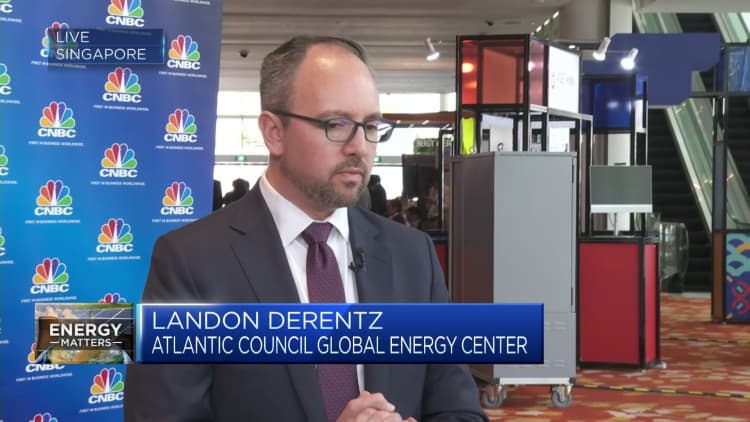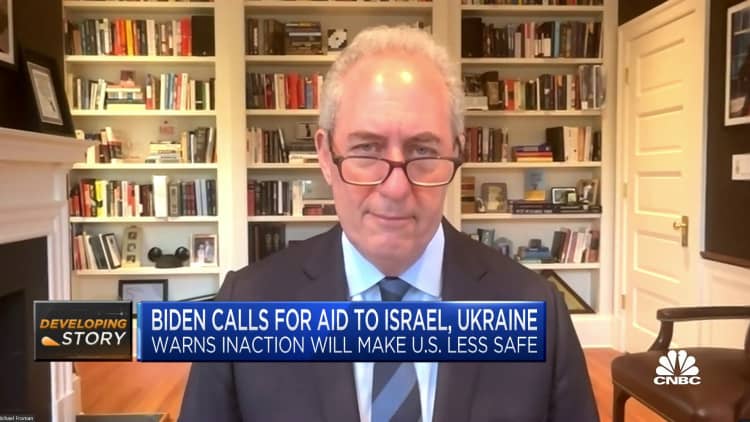Economists fear disruption if conflict not contained

Palestinians gather at the site of Israeli strikes on houses, as the conflict between Israel and Palestinian Islamist group Hamas continues, in the northern Gaza Strip October 23, 2023.
Reuters
Any possible escalation of the Israel-Hamas war poses a major risk to the global economy, driving up energy prices and disrupting key trade routes, economists have warned.
Diplomatic efforts from a slew of international powers have intensified in the hope of containing the fallout from the Oct. 7 attack on Israeli civilians by Palestinian militant group Hamas.
Israel’s subsequent bombardment of Gaza in a bid to eliminate Hamas has increased the risk of a spillover to the wider Middle East region.
Israeli President Isaac Herzog said Tuesday that while Israel does not want a war with Lebanese militant group Hezbollah, which has recently exchanged fire with Israeli armed forces in the north of the country, Lebanon will “pay the price” if the two countries end up in a full-scale altercation.
The events in recent days have deepened the greatest fear among economists, that the conflict engulfs the region and begins to pose a long-term threat to global energy and trade infrastructure.
“Any Middle East conflict sends tremors throughout the world economy because the region is one, a very crucial supplier of energy, and secondly … it is the key shipping passageway for global trade,” Pat Thaker, director of the Middle East & Africa region at the Economist Intelligence Unit, told CNBC on Thursday.
Oil and shipping route risks
The extent to which oil prices will rise, and the knock-on impact to the global economy, will be directly proportionate to how geographically contained the conflict becomes, Thaker explained, adding that the oil market is already tight in the aftermath of Saudi-driven OPEC+ production cuts.
She also noted that the war has begun at a time of “enormous economic uncertainty” as the war in Ukraine continues to rage and central banks reach a tipping point in their monetary tightening cycles.
“For economies that are already in or heading for recession, further hikes from the Fed and the ECB could tip them over the edge,” Thaker told CNBC via videolink.
“We’re going into it with a double whammy here: higher prices once again for energy, but also inflation softening but not radically coming down at a time when interest rates are also the highest we’ve seen in a number of years.”

Oil prices initially leapt after Hamas launched its surprise attack on Israel before moderating slightly, though Brent crude futures were still trading near $89 per barrel on Wednesday morning in Europe while West Texas Intermediate futures hovered just below $84 per barrel.
In the “extreme scenario” of a regional escalation, Thaker predicted, markets will have to contend with Brent over $100 per barrel for a sustained period, which “means higher global inflation, softer economic growth” and “pretty much recession conditions.”
In a research note Friday, strategists at J. Safra Sarasin said oil production from Iran, the world’s eighth largest producer of crude, would be at risk in the event of an escalation, particularly if Tehran is subjected to a renewed tightening of U.S. sanctions, which they estimate would remove up to 1 million barrels a day from global output.
“On top of that, a rise in uncertainty over supplies from Saudi Arabia may easily see prices surge to the same extent as they did in response to the Ukraine invasion in 2022. Back then oil prices gained 30% in a matter of two weeks before settling at around 15% above pre-war levels,” said J. Safra Sarasin Equity Strategist Wolf von Rotberg.

The Middle East is home to the world’s busiest shipping routes, including the Suez Canal, the Red Sea, the Persian Gulf and the Strait of Hormuz, heightening the economic peril associated with escalation.
“Any expansion of the war into the Sinai Peninsula and Suez region increase the risks of an attack on energy and non-energy trade flowing through the Suez Canal, and that accounts for almost 15% of global trade, almost 45% of crude oil, 9% of refined, and also 8% of LNG tankers transit through that route,” the EIU’s Thaker explained.
“You choke off those points and you create major disruption not just to oil prices, but the whole supply chain of the world for energy and other goods as well.”
Emerging market vulnerabilities
Any potential prolonged uptick in energy prices would be a worry for emerging market economies, where energy often accounts for a larger proportion of inflationary pressure than in developed markets, according to Elijah Oliveros-Rosen, chief emerging markets economist at S&P Global Ratings.
“In the typical CPI (consumer price index) basket, energy’s around roughly 10% in EMs. In the U.S., it is 6.9%, so obviously there’s a higher impact on inflation and also, a lot of emerging markets have become net energy importers,” Oliveros-Rosen told CNBC at a press briefing last week.
“So when you start to think about which countries could be more vulnerable to higher energy prices and sustained higher energy prices, you have to start looking at net energy importers with high energy contributions to the CPI basket, and countries like Chile are there, Turkey is there, several Asian economies like Thailand, the Philippines, India, are there.”

Paul Gruenwald, S&P’s global chief economist, said countries that have yet to anchor inflation expectations as their respective central banks tighten monetary policy may be vulnerable.
“If you think about the sequencing of inflation over the last couple of years, when we had the Russian invasion of Ukraine, we had the initial spike in inflation come from food and fuel, and then some of that spilled over to the core and the fiscal stimulus also spilled over into the core,” Gruenwald said.
“Countries that do not have well anchored inflation expectations, this new round of higher energy prices might spill over and we might have a partial repeat of what we went through over the last couple of years.”
He suggested that the “ideal central bank” has convinced the market that it will do whatever it takes to anchor medium-term expectations, so temporary spikes in energy prices can pass through fairly smoothly, but those who’ve yet to achieve this will risk central banks having to react once again with further tightening.
Putting Gaza back together
The scale of devastation wrought on Gaza by Israel’s sustained aerial bombardment will be difficult to assess and quantify for some time, but Thaker suggested economic disruption to countries throughout the region is already becoming clear in the form of widespread protests.
Meanwhile, some future expenditure will be in the geopolitical interests of neighboring powers, such as Egypt and the Gulf states, who are keen to avoid the heated political climate taking hold within their own populations.

“There will be a massive cost of reconstruction. It’s already quite destroyed very much, which is likely to be financed by the Gulf powerhouses, who are anxious to stabilize the situation as well,” Thaker said.
“With Saudi Arabia, the UAE, they’re completely focused on economic diversification and speeding ahead with a number of big ticket projects, so it’s in their interest as well to have wider regional peace and security in order to focus on the home front.”




